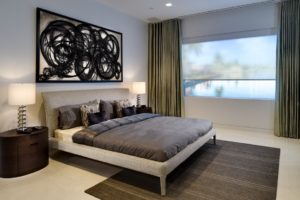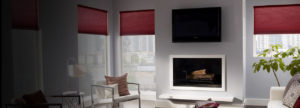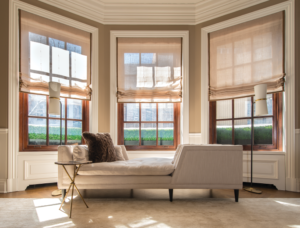Motorized Shades – Benefits and Common Misconceptions

Every home has windows. And, probably most homeowners would agree that window treatments are necessary for privacy and cosmetic appeal. But, should you install motorized window treatments? As a homeowner, you make a significant investment in your home and its interior furnishings. And you likely have an interest in protecting them. Motorized shades bring real value and practical benefits that make them worth the investment.
The top 5 benefits
- Convenience. Manually raising and lowering your shades is easy enough. But how much time do you spend raising them every morning? And then lowering them at night? What about bathroom window? The one you can reach only by stepping into the tub? Or the windows on the second story of a two-story living room? It is quicker to move the shades and drapes with the touch of a button. And, more user-friendly than climbing a ladder every time you want to close those upper blinds.
- Comfort & Energy Savings. Lowering shades in the summer blocks the sun from overheating a room. In the winter, raising the shades allows the homeowner to capture natural solar heat. Both of these scenarios reduce the energy load on the HVAC system. This is especially relevant in our energy conscious world. Take a look at the latest information about smart home technology that is sustainable and reduce your utility bills on Redfin’s recent blog post.
- UV Protection. The sun’s ultra violet rays can be damaging to artwork and furniture. Not to mention wood flooring and expensive rugs. Protect home furnishings from bleaching and fading by setting the shades on a timer or astronomical clock. Since the shades will be lowered during the brightest part of the day, your investments will stay protected.
- Safety, Security & Privacy. When you’re out of town, an effective way to protect your home from intrusion is making it appear as though it’s occupied. Raising and lowering shades at preset times, or controlling them from wherever you are gives an empty house a lived-in appearance. When you’re at home, privacy is key. Lowering all the shades with a simple press of a button makes privacy easily accomplished. Also, motorized shades eliminate any cords, making them a great choice for households with young children.
- Aesthetics. With motorized shades, there are no unsightly cords. Up the wow factor in your home by syncronizing the shades to start and stop in unison, and to line up perfectly across the windows. Shades made from fabrics with open weaves can preserve beautiful views outside while offering privacy inside. There are shading fabric options available to meet every design and need.
Types of Motorized Window Solutions

Wired vs Wireless
Motorized shades are available in battery operated and hardwired solutions, therefore making them an appropriate option for essentially every type of home.
Battery powered shades are great for existing homes where cabling might be too labor intensive. They are also good for retrofitting an older building because they don’t require wiring. Even if you’re not sure you’ll want motorized shades later, if your home is currently under construction, run the wire now. It’s much more cost-efficient to run the wires while the walls are open. Pre-wiring also allows for easy upgrades from manual to motorized window treatments.
Styles
Shading solutions available include roller shades, Roman shades and drapery track systems. Roller shades are the most common form of motorized window treatment. They consist of an aluminum tube with a motor inside that rolls a panel of fabric up and down. The home builder can construct a pocket in the ceiling to completely hide the roller. This makes roller shades a popular choice when building a home. Fabric for roller shades comes in sheer, translucent and room darkening. And in a wide variety of colors.
Roman shades are similar to roller shades. The difference: the fabric folds neatly as it raises instead of wrapping around a tube. The fabric choices for Roman shades are similar to those for roller shades. However, Roman shades can also be made from virtually any fabric. Drapery systems are comprised of fabric that hangs from a motorized track that pulls the drapery from one side to the other. Or, opens the drapes from the middle and pulls them to each side. Like Roman shades, you can choose practically any drapery material you wish.
4 Objections to Motorized Shades… and Why These Might Be Incorrect
- I live in a finished home. I can’t wire for motorized shades. Wireless shades provide an excellent solution. A few D-cell batteries can likely run your shades for 3-5 years… at a very affordable price.
- Motorized shades are difficult to control. You can control a wireless shade almost any way you want. From a dedicated remote control to an app on your phone, a button on your keypad, from a touchscreen or even by sunrise, sunset or time of day.
- Motorized shades are ugly. The most common (and cost-effective) type of motorized shades are roller shades and cellular shades, which tend to have a more contemporary look. This may not fit more traditional home styles. However, Roman shades, and draperies can also be motorized. With Roman shades and draperies, clients are able to select their own fabrics and have them made into motorized shades. It is also possible to combine a non-motorized fabric (like a roman shade or drapes) for looks, with a motorized roller shade for the functional benefits.
- Motorized shades are too expensive. The incremental cost of a motorized shade versus non-motorized is primarily in the motor. In some applications, a single motor can run a large group of shades, further reducing the cost. The fabric options, mounting materials and installation labor are all comparable between motorized and non-motorized shades.
Yes, they are worth the investment!
In conclusion, motorized window treatments are more than visually appealing. They add to the security, privacy, and efficiency of your home. Also, when motorized window treatments are integrated with a smart lighting or automation system, the drapes and/or shades can move in concert with other systems like lighting, music and HVAC.
In addition… what is your time worth? At the Mills offices, we have two large banks of windows. Using the average time to raise and lower shades each day, multiplied by the average cost per employee, we determined that raising and lowering two sets of shades would cost us over $900 per year! So, also factoring in energy savings, our motorized shades actually paid for themselves in under two years.
Therefore, yes, motorized window treatments are worth consideration as an investment in your home.
*Photos courtesy of Crestron



